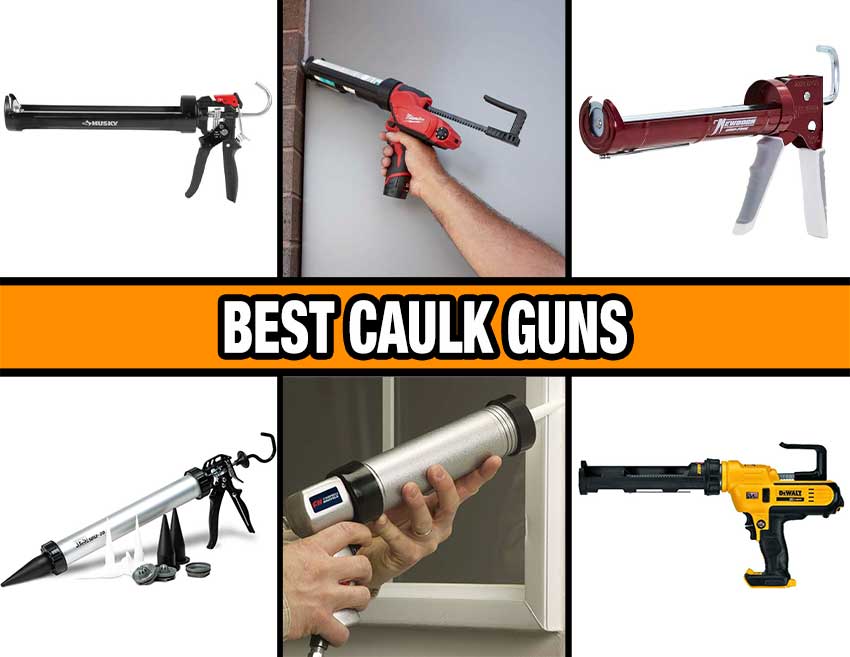Though they might seem like simple tools, finding the best caulk gun can be challenging. Indeed, not all of them are created equal. They can vary significantly in how easily they allow you to lay a bead of caulk. Higher quality models can multiply the power of your grip up to 24 times, making it far easier than cheaper caulk guns to dispense caulk.
Some caulk guns also have designs and mechanisms that prevent them from dripping, allowing you to work around corners seamlessly, and many come with handy built-in tools for cutting caulk cartridge tips and puncturing seals. Along with the traditional manual models, there are also battery-powered caulk guns for pros. Ahead, we’ll take a deep dive into the features you should look for in a caulk gun while reviewing the top 10 models out there.
Our Top Picks
- Best Overall: Newborn 375-XSP Caulk Gun – Buy on Amazon
Jump to this Caulk Gun ↓ - Best Dripless: Newborn 930-GTD Drip-Free Caulking Gun – Buy on Amazon
Jump to this Caulk Gun ↓ - Best Easy to Use: WorkPro Caulking Gun W024006A – Buy on Amazon
Jump to this Caulk Gun ↓ - Most Affordable: Anvil Drip Free Ratchet Caulk Gun HD-117FG-B1 – Buy at Home Depot
Jump to this Caulk Gun ↓ - Best Professional: Dewalt 20V Max Cordless Caulking Gun DCE560B – Buy at Acme Tools
Jump to this Caulk Gun ↓ - Best for Viscous Material: JES 10 oz. 26:1 High-Thrust Caulk Gun M26S – Buy on Amazon
Jump to this Caulk Gun ↓ - Best Cordless: Milwaukee M12 Cordless Adhesive and Caulk Gun 2441-20 – Buy at Acme Tools
Jump to this Caulk Gun ↓ - Best Sausage and Bulk: JES 20 oz. 12:1 SD12-20 – Buy on Amazon
Jump to this Caulk Gun ↓ - Best Large Capacity: Husky 29 oz. Drip-Free Caulk Gun 19PT0903 – Buy at Home Depot
Jump to this Caulk Gun ↓ - Best Air Powered: Campbell Hausfeld PL155800AV – Buy on Amazon
Jump to this Caulk Gun ↓
Also In This Article
- Best Caulk Gun Buying Guide
- Frequently Asked Questions
- Related Content
- Why You Can Trust Pro Tool Reviews
How We Picked the Best Caulk Guns
We used a mix of our experience using various types and brands of caulk guns along with extensive research to help inform our picks for the top caulk guns. We compared build quality, design, thrust ratio, and other important specs and features while also reading through dozens of customer reviews to identify the top models. Our list includes basic ratcheting models for light-duty use, models with high thrust ratios for heavy-duty applications, and motorized caulk guns for those who make a living caulking other people’s kitchens and bathrooms.
The Best Overall Caulk Gun
Newborn 375-XSP Super Smooth Rod Revolving Frame Caulk Gun
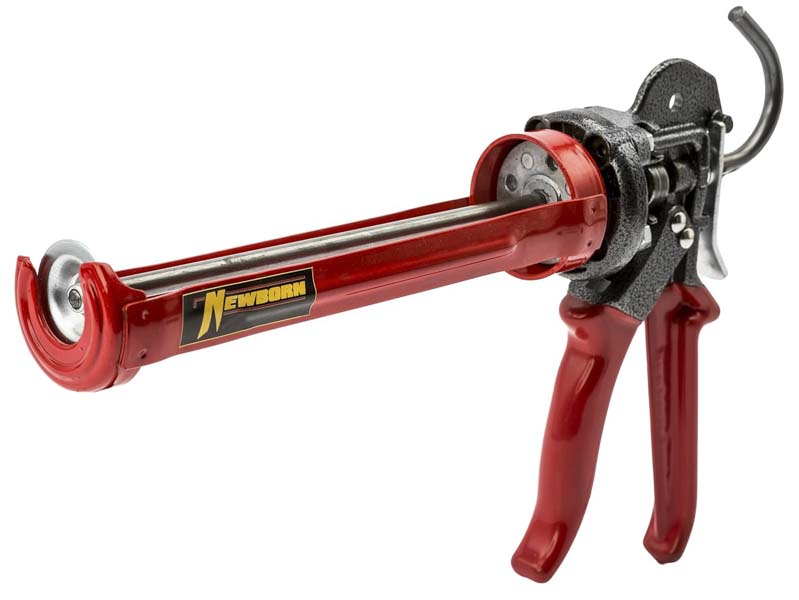
A rock-solid build and high thrust ratio make this one of the best caulk guns you can add to your arsenal of tools. With a high 26:1 thrust ratio and smooth pressure rod, you don’t need to apply a lot of force to run a bead of caulk even when working with more viscous material. We also like the excellent build quality, which is apparent in its pumping mechanism, heat-treated rod, cast parts, and heavier gauge metal. The handle also has a rubber covering that makes it more comfortable to use, and a revolving frame helps keep your bead smooth as you navigate corners. Our only gripe is that we wish it had a dripless design.
Pros
- High thrust ratio
- Rotating frame
- Durable built quality
Cons
- A little pricey
- No anti-drip mechanism
Key Specs
- Rod type: smooth
- Non-drip: No
- Thrust Ratio: 26:1
Price: $49.99
Best Dripless Caulk Gun
Newborn 930-GTD Drip-Free Caulking Gun
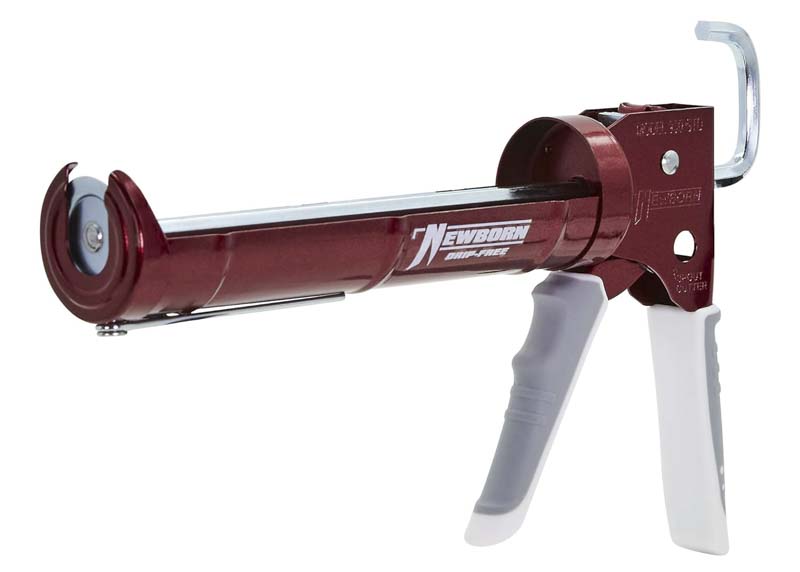
The Newborn 930-GTD comes equipped with a plunger that automatically pulls back after you release it, giving the caulk somewhere to expand to so it doesn’t come dripping out the tip when you don’t want it to. The 930-GTD also happens to be very well made with a solidly built trigger mechanism and a frame made from heavier gauge metal than most. We also like the trigger on this caulk gun, which has a molded ergonomic shape and rubberized padded grip that will keep your hand more comfortable over longer caulking jobs. Just keep in mind that the 930-GTD’s thrust ratio of 10:1 makes it suitable for mainly low-viscosity materials.
Pros
- No-drip design
- Comfortable cushioned grip
- Great build quality
Cons
- No rotating frame
- Only for use with low-viscosity materials
Key Specs
- Rod type: smooth
- Non-drip: Yes
- Thrust Ratio: 10:1
Price: $12.19
Best Easy To Use Caulk Gun
WorkPro Caulking Gun W024006A
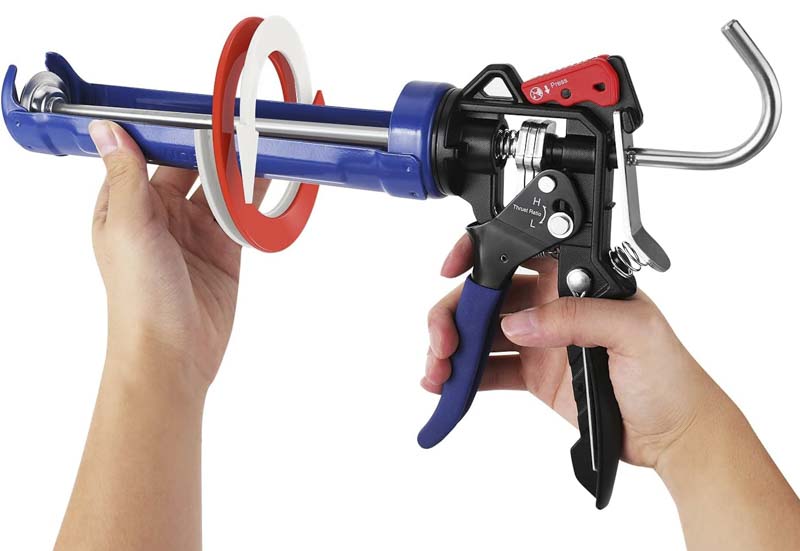
WorkPro gives you more control over how much caulk you’re pushing out than most manual caulk guns out there. You can change flow rates from a thrust ratio of 18:1 for thicker materials down to a low setting of 9:1 for thinner caulks and sealants. There are also drip controls on the trigger that you can engage on the fly to cut off the flow of caulk, allowing you to make a clean mess-free transition. A rotating barrel is handy for working around corners while a smooth rod makes it easier to get a consistent bead. We also like the cushioned grip, which takes the pressure off your hand over longer caulking efforts.
Pros
- Adjustable flow rate
- Drip controls
- Rotating barrel for corners
Cons
- A little heavy
- Lower thrust ratio than some
Key Specs
- Rod type: Smooth
- Non-drip: No
- Thrust Ratio: 18:1 or 9:1
Price: $21.99
The Most Affordable Caulk Gun
Anvil Drip Free Ratchet Caulk Gun HD-117FG-B1
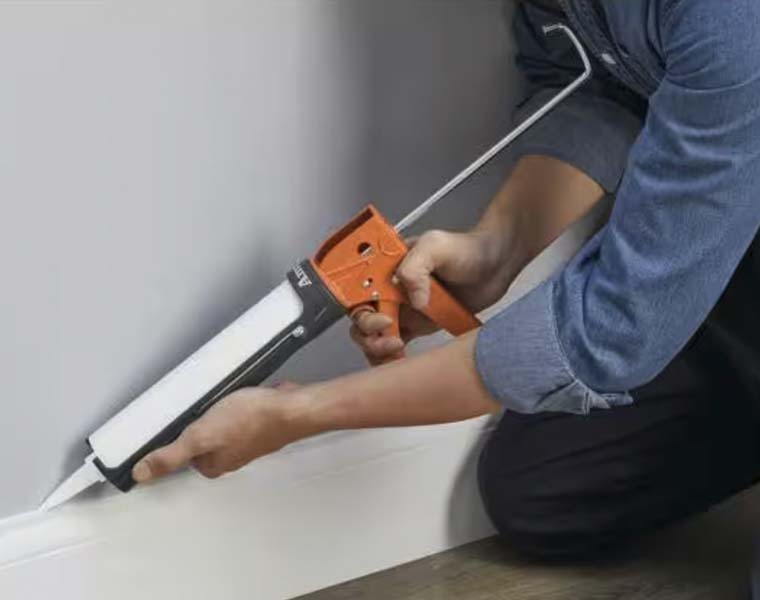
If you only find yourself caulking now and then, there’s no point in investing a lot of money in an expensive model. This affordably priced caulk gun from Anvil will get the job done at a rock-bottom price. While it doesn’t offer some of the features you’ll find on higher-end models, such as a smooth rod and high thrust ratio, it does have a few nice extras. It also has a drip-free design, there’s a rotating barrel for working in tight spaces and it comes equipped with a built-in spout cutter and seal punch. Just keep in mind that with its higher thrust ratio, it’s suitable for light to medium-duty jobs.
Pros
- Built-in spout cutter
- Drip-free design
- Affordably priced
Cons
- Low thrust ratio
Key Specs
- Rod type: ratcheting
- Non-drip: Yes
- Thrust Ratio: 8:1
Price: $10.98
Best Professional Caulk Gun
Dewalt 20V Max Cordless Caulking Gun DCE560B
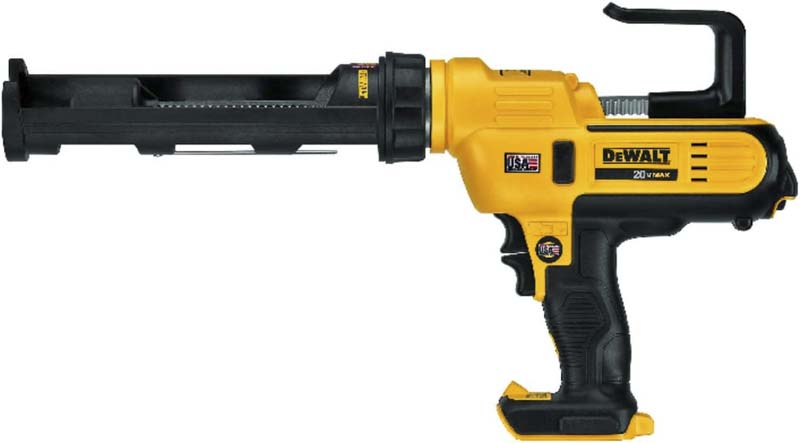
If your job requires you to spend your days running beads of caulk, then it makes sense to invest in a tool that will allow you to get the job done faster while saving your hand. Dewalt’s cordless caulk gun is a great option, especially if you’ve already bought into the brand’s line of 20-volt cordless tools (and hence own a Dewalt charger and batteries). This model, which holds 10-ounce canisters, comes equipped with a speed dial that allows you to set maximum and minimum flow rates and a variable speed trigger. There’s also an anti-drip feature that automatically retracts the plunger when you take your hand off the trigger and a tray that lets you fit different canister sizes into the gun.
Pros
- Variable speed trigger
- Controls for flow rate
- Anti-drip feature
Cons
- Pricey
- Bulky size
Key Specs
- Rod type: N/A
- Non-drip: Yes
- Thrust Ratio: N/A
Price: $219.99
Best Caulking Gun for Viscous Material
JES 10 oz. 26:1 High-Thrust Caulk Gun M26S
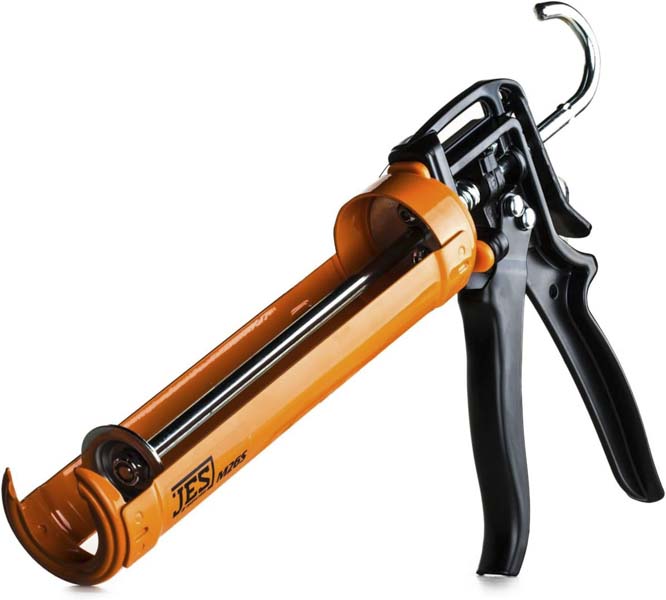
When you’re working with extremely thick caulk, sealant, or adhesive, you’ll need a caulk gun with a high thrust ratio that’s capable of pushing that material out without requiring you to exert a gorilla-like grip on it. This model from JES, which works with 10-ounce cartridges, can handle the job thanks to dual thrust plates that give it a powerful 26:1 thrust ratio. Along with all that force, it also has a rotating frame for working in and around tight spaces, a built-in pin for puncturing cartridges, and a hook for hanging it on a ladder. We also like the JES’s build quality with its heavy gauge metal construction and a thick enamel protective finish that covers the barrel and handle.
Pros
- High thrust ratio
- Durable build quality
- Rotating frame
Cons
- No non-drip feature
Key Specs
- Rod type: smooth
- Non-drip: No
- Thrust Ratio: 26:1
Price: $26.25
Best Cordless (Electric) Caulking Gun
Milwaukee M12 12V Cordless Adhesive and Caulk Gun 2441-20
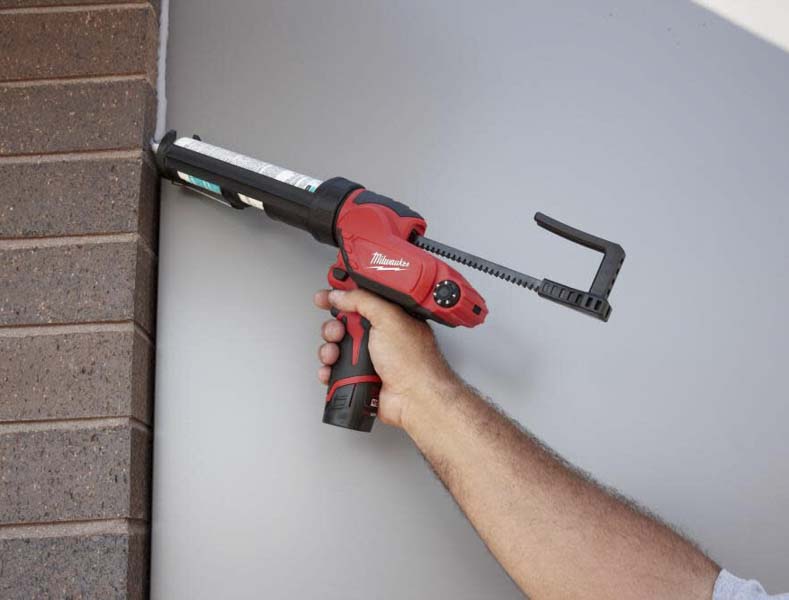
If laying beads of caulk is in your job description then the M12 may be a worthy investment. This cordless powered caulk gun, which is part of Milwaukee’s M12 system, uses a motor and not your grip to force caulk out of the tube, allowing you to get the job done faster while saving your hand. The M12, which holds 10-ounce tubes, can handle most types of caulk thanks to the 400 lbs. of force it produces. It also gives you a surprising amount of control over how much caulk it distributes thanks to a speed dial and a variable-speed trigger. Other notable features on this automatic caulking gun include a rotating collar that makes it easier to maneuver the gun around corners as you’re running a bead and an auto-reverse function that engages when you release the trigger to create suction that prevents drips.
Pros
- Rotating collar
- Variable speed trigger and speed dial
- Produces 400 lbs. of force.
Cons
- Expensive
Key Specs
- Rod type: smooth
- Non-drip: No
- Thrust Ratio: N/A
Price: $159
Best Sausage Caulk Gun
JES 20 oz. 12:1 Sausage and Bulk Caulk Gun SD12-20
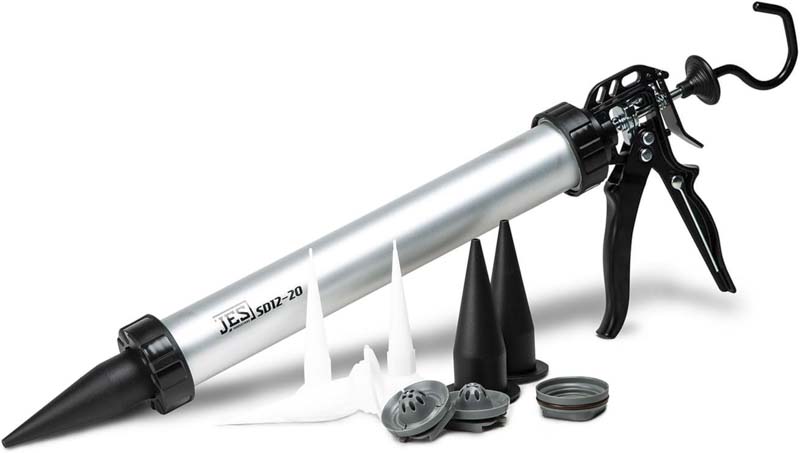
This Pro-level caulk gun from JES checks all the boxes in what one needs from a sausage caulk gun. It has a high 12:1 thrust ratio, which makes it a good choice for applying various types of caulk, including acrylic, silicone, and polyurethane. It’s versatile too. It will work with sausage packs, cartridges, and bulk caulk. Plus, it’s easy to convert between each one. It has a sturdy build with a heavy gauge metal barrel and a high-quality finish on the trigger, rod, and plate. It also comes with eight different nozzle attachments to suit different applications, giving it the ability to handle pretty much any caulking job you can think of.
Pros
- Works with sausage packs, cartridges, and bulk caulk
- Numerous nozzle attachments
- Heavy duty built quality
Cons
- Expensive
Key Specs
- Rod type: smooth
- Non drip: no
- Thrust Ratio: 12:1
Price: $56.65
Best Large Capacity
Husky 29 oz. Drip-Free Caulk Gun 19PT0903
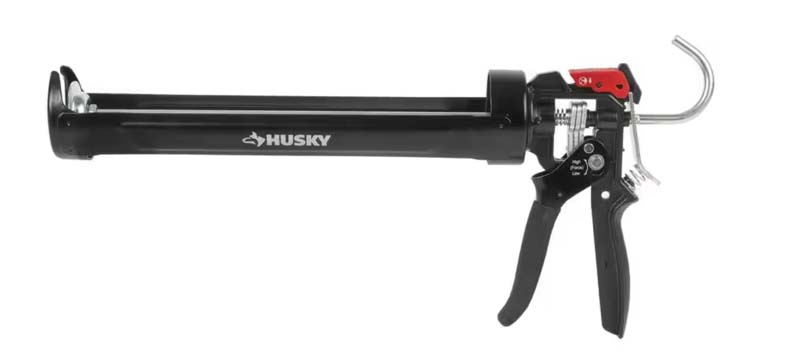
For larger caulking jobs, there’s this 29-ounce caulk gun from Husky. With its ability to hold larger 29-ounce cartridges, you can save money on larger bulk-size cartridges and go for much longer before having to reload. We also like the versatility of this caulk gun. You can switch between a thrust ratio of 9:1 and 18:1 to suit the viscosity of the product you’re using, and there’s a button that allows you to switch between drip and drip-free. Other notable features include a rotating frame, integrated seal punch, ladder hook, and cushioning on the trigger grip. The only thing missing is a tip cutter for caulk cartridges.
Pros
- Adjustable thrust ratio
- Drip and drip-free settings
- Rotatable barrel
Cons
- Doesn’t include a tip cutter
Key Specs
- Rod type: smooth
- Non drip: yes
- Thrust Ratio: 9:1 and 18:1
Price: $24.98
Best Air Powered Caulk Gun
Campbell Hausfeld Air Powered Caulk Gun PL155800AV
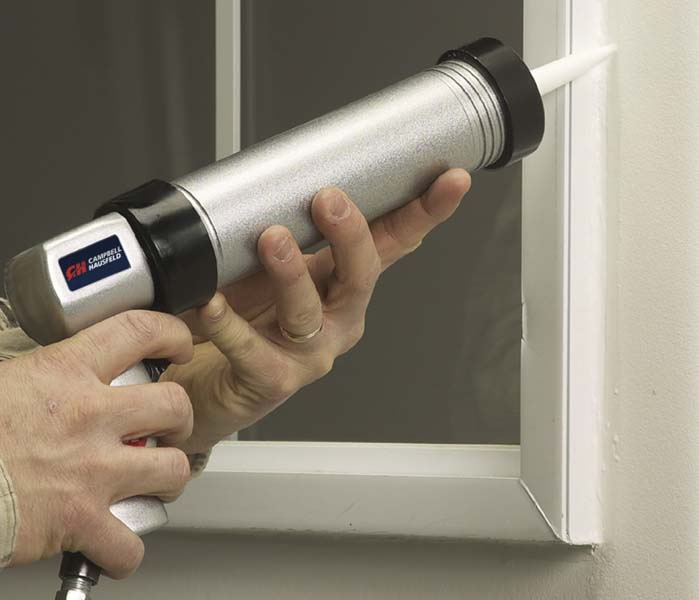
We like the simple design of this pneumatic commercial caulking gun from Campbell Hausfeld. It uses standard 10-ounce cartridges, is compatible with sealants, adhesive, and caulks and works with a standard air compressor. We also like the shut-off valve stop design that prevents material from dripping out after you release the trigger, eliminating messes while making it easier to maintain an even bead. This caulk gun has a sleek design and excellent build quality yet weighs just 2.8 pounds, making it easy to work with, though the trigger is a little awkward and uncomfortable to squeeze.
Pros
- Great build quality
- Drip-free design
- Light overall weight
Cons
- Trigger is awkward to operate
Key Specs
- Rod type: N/A
- Non drip: yes
- Thrust Ratio: N/A
Price: $50.79
Best Caulk Gun Buying Guide
Types of Caulking Guns
Manual Caulk Guns
Manual caulk guns have a trigger you squeeze with your hand to manually force the caulk out of the tube. You apply the caulk by maintaining consistent pressure on the caulk gun trigger with your hand. While this allows for good control of the amount of caulk you’re releasing, manual caulk guns can wear out your hand if you’re caulking an entire bathroom or if your job requires you to apply caulk regularly.
Manual caulk guns come in two types, ratchet lever and smooth rod caulk guns.
Ratchet lever caulk guns work by pulling the trigger to advance a rod that applies pressure to the caulk tube. This type of caulk gun usually has a low thrust ratio of around 5:1, which means you need to squeeze hard on the trigger to dispense caulk.
Smooth rod caulk guns give you more control over how much caulk you release with each squeeze. And since they have thrust ratios that can reach as high as 26:1, you don’t have to apply as much pressure with your hand to dispense caulk. This makes them an ideal choice for bigger jobs or caulks, adhesives, and sealants with a high viscosity.
Pneumatic Caulk Guns
A pneumatic caulk gun uses air power instead of your hand to force the caulk out of the tube. You can also regulate how quickly it releases caulk by adjusting the air pressure. You’ll need an air compressor to use this type of caulk gun, which can make it inconvenient for some jobs, such as caulking a bathroom.
Battery-Powered Caulk Guns
This type of caulk gun uses a rechargeable lithium-ion battery to power the caulk gun. Some come equipped with variable speed triggers that allow you to control how quickly it propels the caulk out of the tube. While battery-powered caulk guns are ideal for those who want to save their hands during a bigger job, they require a recharge after about two to three hours of use.
Sausage Caulk Gun
This type of caulk gun can use caulk sausage packs as well as caulk cartridges. Sausage packs are more economical, hold more caulk, and tend to create less mess than caulk cartridges. Sausage caulk guns also come with a variety of nozzles, making it easier to get the right size bead.
Caulk Gun Size and Capacity
Caulking gun sizes include 10-ounce models and the larger-capacity 29-ounce caulk guns.
10 Ounce
This is the standard-size caulk gun that is capable of taking 10-ounce caulk, sealant, or adhesive cartridges. This size is suitable for most caulking projects you’d need to take on around the home. Even if you have a larger job to do, you can reload a 10-ounce caulk gun quickly.
29 ounce
If you spend many days each week caulking other people’s bathrooms and kitchens for a living, it may make sense to go with this larger caulk gun that can hold 29-ounce cartridges. With its large capacity, you can go significantly longer before needing to change out the cartridge. You can also save money by purchasing higher-capacity cartridges.
Thrust Ratio
One of the most important specs to consider when shopping for a caulk gun is thrust ratio. Thrust ratio determines how much pushing power the caulk gun produces when you pull the trigger. The greater the thrust ratio, the less effort it takes to squeeze the trigger to dispense caulk. The best caulk guns have a ratio of around 26:1, while cheap models may only have a thrust ratio of 5:1. If you’re a pro, have a large caulking project to complete, or are working with a high-solids caulk that is more viscous, spring for a model with a high thrust ratio.
Additional Features
Revolving Frame
This key feature allows the frame of the caulk gun to rotate as you’re working around corners, making it much easier to maintain an even and uniform bead through these turns.
Nozzle cutter/Poker Rod
Some caulk guns come with a built-in tool for cutting the nozzle on caulk cartridges. This is a handy extra feature that eliminates the need to hunt for a utility knife or cutters to clip the end of the cartridge off. Some caulk guns also include a poker rod for puncturing the inner seal on caulk cartridges.
Ladder Hook
Some caulk guns have a rod that loops around after it runs through the gun’s trigger mechanism. This design is handy for hanging the caulk gun on a ladder when you need to free up your hands.
Drip-free
When you pause while caulking, the material will typically expand, sending more of it out of the tip of the caulk canister, causing drips and messes, while also wasting the product. Some caulk guns have a plunger that pulls back automatically when you release the trigger, removing pressure from the canister to prevent drips.
Adjustable Thrust Ratio
Some caulk guns allow you to adjust the thrust ratio to low or high settings. This makes the caulk gun more versatile, allowing you to adjust the thrust setting to suit the viscosity of the material you’re working with.
Caulking Gun Uses
Bathroom and Kitchen Sealing
One of the most common uses for a caulk gun is to seal the cracks and seams in bathrooms and kitchens around sinks, showers, and tubs. Sealing cracks around these plumbing fixtures is essential to prevent water from the adjacent faucets from finding its way into these openings, where it can cause mold and rot to form.
Window and Door Sealing
A caulk gun is also an essential tool for sealing small gaps around windows and doors to prevent air or moisture from passing through.
Roof and Gutter Sealing
Caulk is also commonly used on gutters to make seams watertight or to repair any leaks that have formed in the gutter. Caulk guns can also be used for roofing to make repairs or to seal areas around vent pipes, chimneys, and other openings on your roof.
Carpentry and Construction
A caulk gun is a useful tool for finishing carpentry work. By laying a bead of caulk around cabinets and shelving, you can create a seamless between built-in furniture and the surrounding wall. Caulk guns are also useful for closing gaps between newly installed baseboards, molding, and crown molding and the wall. You might also use a caulk gun to apply construction adhesive for a variety of different projects, such as mounting a bathroom mirror or installing molding.
Miscellaneous repairs
A caulk gun is a handy tool to have for a variety of applications around the house. You can use one to fill cracks and gaps to keep pests from invading your home. You can also use a caulk gun to apply roof sealant or patch to repair leaks or holes and gaps in concrete.
Automotive Applications
Caulk guns are also used in the automotive industry. Glas technicians use them when installing a new windshield to create a watertight flexible seal between the glass and the body of the car.
Safety and Handling Considerations When Using a Caulk Gun
Caulk guns are among the safer tools you can use, but there are a few precautions you should take when using one. While the fumes released from caulk have low toxicity levels, they can still be mildly irritating. If possible, open a window and set up a fan to help ventilate the area in which you’re working.
Caulk doesn’t prevent a significant hazard to your skin, but it’s still not a bad idea to wear gloves when applying it, especially if you plan on using your finger to smooth the bead of caulk. Caulk is designed to resist water which makes it difficult to clean off your skin.
Storage
There are a few ways to store a partly used caulk cartridge, so it doesn’t dry out. If you’ve cut a larger tip on the caulk, plug it with a nail then wrap some duct tape or electrical tape around the nail head to create an airtight seal. If the hole in the tip is too small for a nail, wrap the end in plastic wrap. After covering the tip, place the entire cartridge in a sealable plastic bag.
Frequently Asked Questions About Caulk Guns
What is a caulk gun, and how does it work?
A caulk gun is a tool for applying caulk, sealant, and adhesive for various applications. A caulk gun works specifically with caulk cartridges that are designed to fit into the gun. Caulk comes in cartridges with a tip you cut to the desired size of the caulk bead you want to create. Once placing the cartridge in the gun, you pull the trigger, which pushes a plunger forward, creating pressure on the cartridge that causes the caulk to dispense from the tip.
What types of caulk can I use with a caulk gun?
You can use several types of caulk in a caulk gun, including latex, acrylic, and silicone caulk along with rubber-butyl sealant, masonry repair sealant, and silicone sealant. Along with caulk, caulk guns also work with construction adhesive.
How do I load caulk into a caulk gun?
First, cut the tip of the caulk gun and puncture the seal. Next, press the release trigger on the handle and pull the plunger back. Insert the cartridge into the gun heel first. Squeeze the trigger a few times to push the plunger into the cartridge and start a bead.
What are the common issues with caulk guns, and how can I troubleshoot them?
If your caulk gun isn’t working properly, start by cleaning it. Remove the caulk tube, pull the plunger back, and press the trigger. If it doesn’t move forward, there may be a problem with the mechanism. Check to see if caulk residue is clogging the trigger. If so, soak the gun in mineral spirits to remove it. If that’s not the issue, check the spring to see how taut it is. A caulk gun won’t work with a worn-out spring. If the spring is the culprit, you’ll need to replace the whole gun.
Can I use a caulk gun for other applications besides sealing?
While caulk guns are used primarily for laying beads of caulk and sealant, they’re also handy for applying construction adhesives, such as you might use to install a bathroom mirror, backsplashes, crown molding, tile, and a variety of other materials.
Related Content
Why You Can Trust Pro Tool Reviews
Ever check out a “review” site and you can’t tell if the author has any real experience with tools or if they’re just “recommending” the Amazon top sellers? That’s not us. We won’t recommend anything unless we’d use it ourselves. It’s all about giving you a legitimate recommendation and our honest opinion of each product.
We’ve been in business since 2008 covering tools, writing reviews, and reporting on industry news in the construction and lawn care industries. Our Pro reviewers work in the trades and have the skills and experience to know whether tools can perform well in the field.
Each year, we bring in and review more than one hundred individual products. Our team will put our hands on hundreds more at media events and trade shows throughout the year.
Pro Tool Reviews consults with innovators in the technology and design of tools to gain a broader grasp of where these products fit and how they work.
We work with more than two dozen professional contractors nationwide who review products for us on real job sites. We consult with them extensively on testing methods, categories, and practical applications.
Our site will provide several hundred pieces of new content this year absolutely free for our readers. That includes objective evaluations of individual tools and products.
The result is information you can trust because of the editorial, scientific, and real-world professional experience we collectively utilize each and every time we pick up and test a tool.

